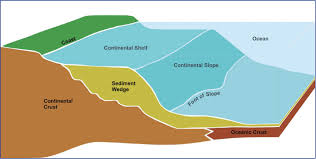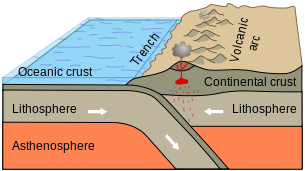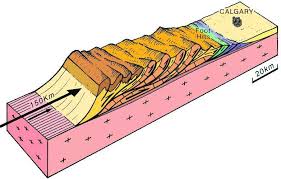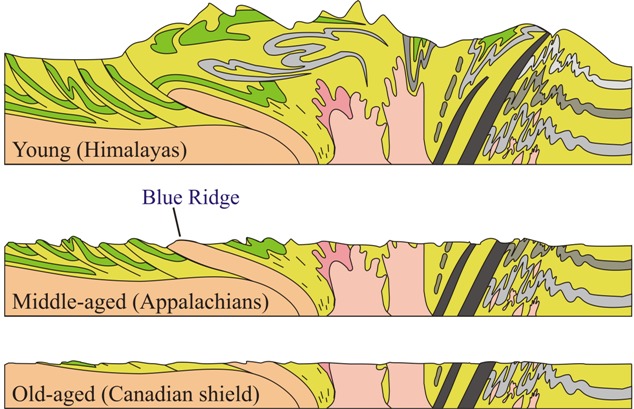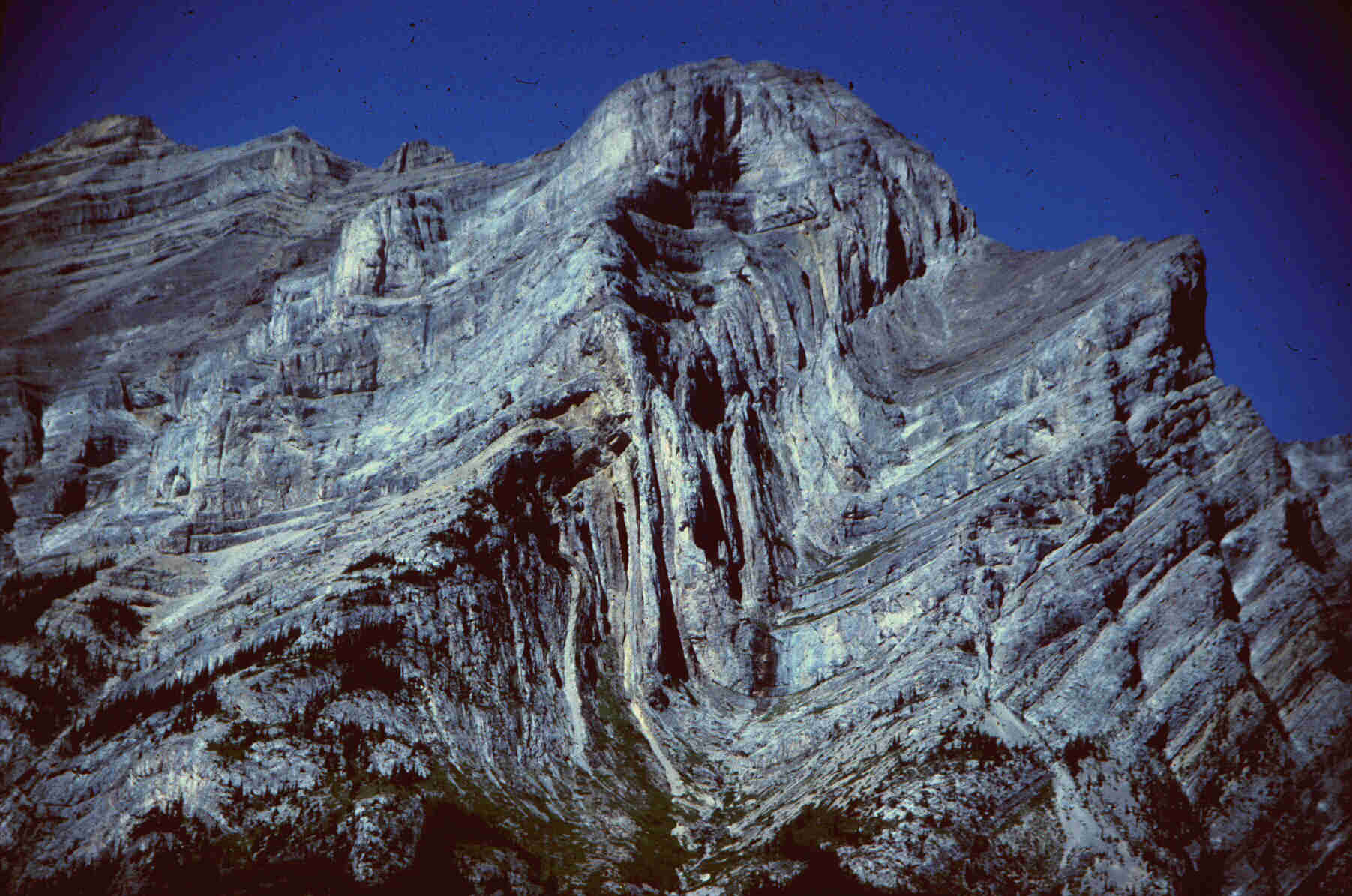Mountain belts are at convergent plate boundaries. Generally, they are formed by marine sediments, intensively folded and fractured. How could they end up so high?
We mentioned earlier that if continental rift zones would continue to evolve they will become new oceans. After marine transgression, the new ocean’s margins (the coasts of the two new separated continents) will see marine sedimentation starting; if climate would allow it, evaporites will deposit first at the bottom of a typical marine transgression series.
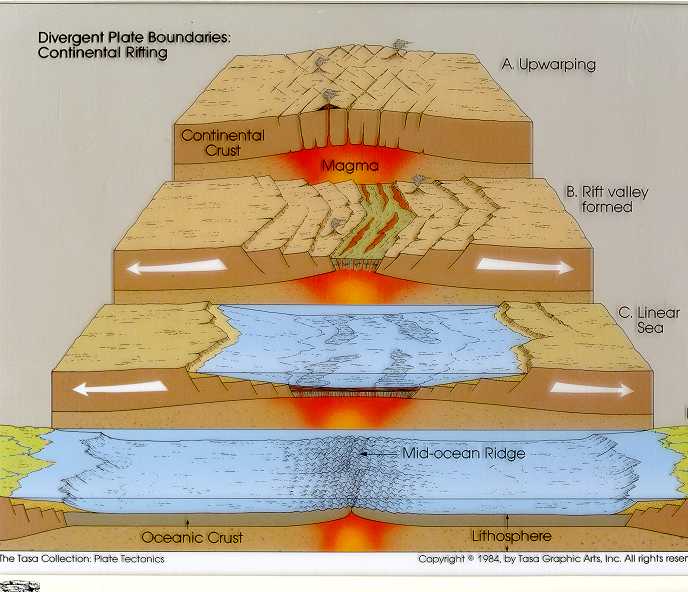
Development of a divergent (active) boundary
Sediments from the continents (from the erosion of mountain belts) will be transported to the new sea by water streams and winds to be deposited at the margins of the new continents. The margin will therefore develop a “sedimentary prism” or “continental wedge” (modern version of the old geosyncline concept). Such a sedimentary wedge is a system of sedimentary sequences that forms the continental platform and slope. This is, for example, the current situation at both Atlantic margins. A well-known continental rift zone is in Eastern Africa and it has already evolved to a proto-ocean under the Red Sea.
If relative plate motions change direction, two continental wedges may eventually converge. Before the two wedges will collide, it is necessary the oceanic lithosphere in between is almost completely consumed through one or more subduction zones with relevant seismicity and island arcs. The first sediments that will be involved in the collision are the most “internal” ones, those deposited on the oceanic crust (once called eugeosyncline).
This “involvement” is called “tectonization”: the more ductile sediments will be folded by the ensuing compression; most part will be displaced along reverse fault planes to form the first “thrust sheets”. The direction of thrusting (vergence) will depend on the direction of subduction (that may also change during the mountain belt evolution). Sediments stacking will lead to increasing sinking, therefore increasing temperature and pressure. Well-bedded sediments will be able to deform in a ductile fashion up to metamorphic conditions. In the deepest zones, the portion with lower melting point of the high-grade metamorphic rocks will melt into granitic magmas at about 500-600°C (anatexis), that will almost completely solidify before reaching the surface. Their high viscosity will prevent them to move freely and they will form granitic-granodioritic plutons, batholiths, sills, and dikes supporting the newly formed belt, with their “metamorphic aureole” in the containing “country rocks”.
The combination of all described phenomena that occur before the actual uplifting is called “tectogenesis”. The resulting thickened assemblage of packed granitoid and sedimentary material will then be in isostatic unbalance; the mountain belt will therefore be progressively uplifted. This phenomenon is called “orogen(et)ic process”. It allows sediments that were once deposited undersea to be raised high for thousands of meters. The highest parts of the mountain belts may contain sequences of basic igneous rocks called “ophiolites”, which correlate well to oceanic sequences sampled in the seafloors. They should be a part of the shallowest portion of the oceanic crust, scraped away during subduction; most probably, it is oceanic crust from the back-arc basin, young enough to be thin and light, hence more easily brought up (obducted) than subducted.
The orogeny example described above is well represented by the Alpine-Hymalaya orogeny, where Africa, Arabia, and India moved to north closing the ancient Tehys ocean that once separated them from Eurasia.
For an orogenic processes to take place a single continental wedge is enough – there’s no need for to continents to collide. For example, in the Andes the western South American wedge has been deformed by the converging Pacific lithosphere, which is subducting underneath it with a rather low angle. In fact, in the most internal areas there are imposing volcanoes formed by the raising magma generated by the subduction process.
Mountain belts are structured in several thrust systems. As already said, the innermost sediments are the first to be involved. The horizontal compression generates gently dipping fault planes along which the more internal material is dragged towards the continent over the more external one. Generally, the slip begins along the bedding surfaces, geological boundaries with different behavior under deformation.
Once in a while, the slip cuts up through the sedimentary sequence to resume slipping along the bedding on a shallower level. Next thrust sheets will develop ahead, towards the continent. Newly generated sheets will overthrust more external sequences; the more external and recent thrust sheets will transport “piggy-back” the more internal less recent thrust sheets, that will so stop slipping. Therefore, the more internal deposits that once were on oceanic crust (called eugeosyncline in the past) will be uplifted to the highest peaks (ophiolites), overthrust on more external sediments originally deposited on continental crust (once called miogeosyncline). This packing results in crustal thickening and in the subsequent metamorphism, anatexis and uplifting phenomena described above. Most of the mountain belt’s structure is buried deep as a tectonized wedge sunk in the mantle. The belt is just like the tip of a floating iceberg…
Once uplifted, a mountain belt is inevitably exposed to weathering. As it is being dismantled by weathering agents, the belt becomes progressively lighter. This causes further isostatic uplift, just like for a melting iceberg. The uplifting continues as long as mountain roots (the submerged part of the iceberg) are available. Once the roots are consumed, their metamorphic and igneous rocks will be eventually exposed at surface, forming the so-called continental shields. In northern Scandinavia, Siberia, northern Canada, Brazil, parts of Africa and Australia, metamorphic and igneous rocks once at the roots of ancient mountain belts, form continental shields. The sediments that once made the mountains above them are now at their margins as sedimentary wedges (continental platform and slope); the continental shield-plus-wedge system is called “craton”.
Subduction processes thus complete the Theory of Ocean Floor Expansion proven by the Vine and Matthews hypothesis: they are recycling mechanisms where oceanic litosphere is consumed while melted portions of it rise again to form new continental litosphere: the latter is hence derived from the oceanic basaltic rocks, primordial in composition; the subducting oceanic lithosphere’s more acid fraction melt to form new continental crust. Erosional processes transform the new continental crust into sediments deposited at continental margins, ready to be involved in a new orogenic process.
The theory of Continental Drift and the theory of Ocean Floor Spreading are thus unified into the theory of Plate Tectonics or Global Tectonics. It provides a satisfactory explanation for the vast majority of geological processes observed to date. The geological setting of any area of the planet can be fitted within the framework of Plate Tectonics. Its global applicability has established it as the great unifying theory of Geology.
